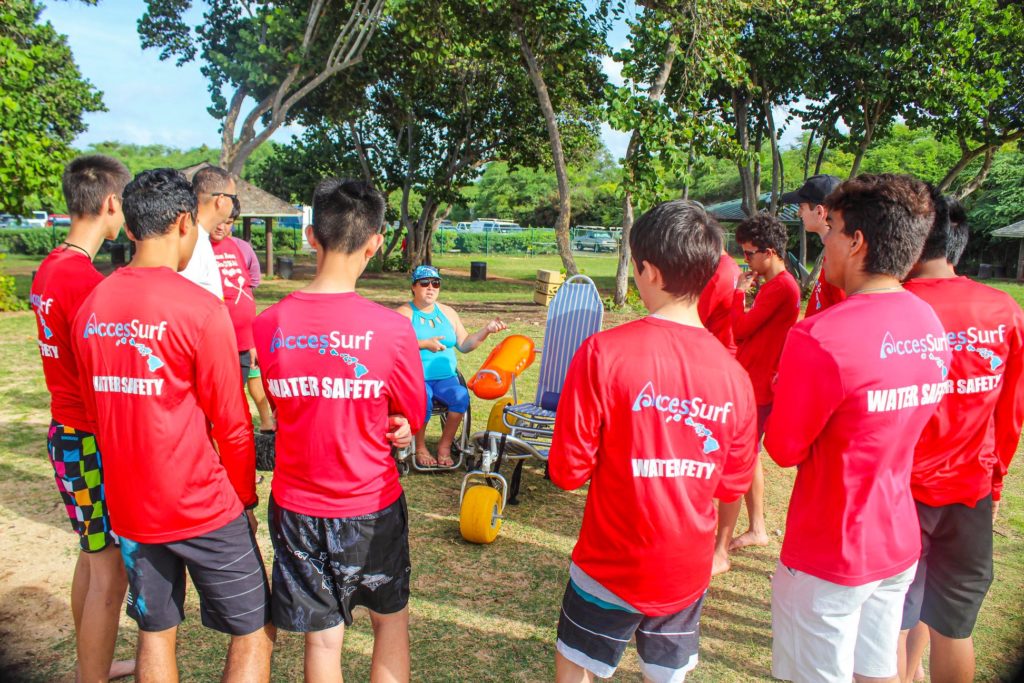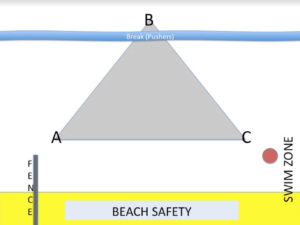
On-the-job training requirements for the potential water safety volunteer:
- Skilled longboard paddler
- Skilled swimmer and water tread
- Lifesaving certified preferred
- Skilled leader and communicator
General Watersafety Briefing
Teamwork
-
- We work together with surf instructors, pushers, beach safety, and other roles at events to promote safety, communication, transfers, boundaries, and having fun.
Safety
-
- Always have two people per board coming in and out of the water.
- Lead participant and instructor to sandy part of beach break and near fence line if current is bad for entrance and exit, and the safest distance past the shore break “impact zone.” This will change with conditions and tide.
- Instructor normally assists the participant while water safety stabilizes the board and assists as necessary, including coordinating and listening to the instructor in regards to how to proceed with entry and exit.
- The board should always be perpendicular to the waves and no one should be allowed between the board and the beach.
- Instructors ensure a clear “lane,” while water safety alert instructors if there is a problem.
- Stay calm in all situations and use effective communication strategies with others, in and out of water.
- Listen to participant if they have a preferred, established process to surf/swim.
Communication
-
- When the instructor is coming back in, find out how the participant wants/needs to be transferred. The Instructor may need to wait farther out from the shore break until transfer resources are available. Relay need for transfer chair and or additional volunteers. Always use eight volunteers if carrying board with participant on the board. There is no rush, let the ocean help you in and out of the shore break.
- Listen for needs of the participant: communicate safe conduct before and while in the water.
- If communication is an issue, clear the entry, during, and exit processes with a caregiver and/or water safety team member before entry into the water.
Environmental Boundaries
-
- Point out fence line, center position, and left swim area buoy (A, B, and C positions).
- Conditions will dictate how far out the positions sit but instructors must stay within those boundaries.
- Line up using palm trees, yellow tents
For all:
-
- Stay hydrated! Use sunscreen! Take breaks! (Let key leader know when needed.) Be safe! And have FUN!!
- Demonstrate skills before taking on role
Separate Water Safety Briefing
- Beach Safety Role
-
- Beach safety can be the most dangerous and challenging. Key function is to stabilize board for the instructor and safety for the Instructor and participant. Reiterate essentials: two people per board; board is always perpendicular to waves; never let anyone between the board and the beach.
- Consider wearing footwear.
- Scan the ocean for returning instructors and trouble and shore break to assist others.
- Stay upwind from boards to avoid boards flying into people.
- Ask three seasoned water safety personnel to be on call for first rotation.
- Perimeter Role
-
- Perimeter has its own challenges (ask who has experience with surfing and would like to do this. Let those new volunteers that raise their hands know that there will be a long board skills test). Reiterate A, B, and C positions and that staying in position is important. Person closest to instructor requiring assistance will render help and then return to position. When assisting, be aware of board positions and that no one is between the board and the beach. Others should stay in position unless needed. Keep an eye out for larger and/or more challenged participants. Keep instructors within the perimeter. Rotations occur every 15-20 minute in a clockwise rotation. A blue board is used to transfer to and from the rescue boards. Always leash up. One rescue board stays on the beach. No surfing the rescue boards!
- Test new personnel that want to try perimeter duty by having them paddle a rescue or long blue board out to a breaking area. They must be able to: maintain position for two minutes, turn the board quickly in both directions; paddle the board in with complete control.
- Fall and recover with contact on board.
Zone water safety

At AccesSurf events, we usually opt for a zone water safety method. This method requires frequent rotation to avoid fatigue of the volunteers. The photo shows the zones that water safety is placed to ensure watch. The perimeter is another place where safety may be placed to maintain boundaries especially during a windy day. Surfers should be directed to paddle outside the triangle to avoid collisions and wave interferences.
-
- Waving both arms and splashing – needs immediate help, emergency
- Waving only one arm – needs assistance
- Making an “O” by touching the top of head – question AND answer- “are you OK?” “yes”
- Volunteer making a “T” with his/her hands – need transfer chair
- Red flag from the beach – everyone out of the water immediately. All transfers needed.
One of the many ways we communicate in the water, the “ok” signal can be a question or answer between volunteer and the AccesSurfer or between volunteers in the water or on land.
Our Team Roles
The surf instructor, pusher, and catcher are part of our team.
Surf Instructor: Skills and Expectations
- Water safety
- Can the volunteer control longboards?
- Must demonstrate knowledge of surf zone and swim zone
- Know responder role
- Control boards
- Be conscious of leashes and their dangers
- Be able to get participants back on board, conscious or unconscious
- Shadow surf instructor
- Demonstrate knowledge of surf lanes
- Must show appropriate spacing when surfing a party wave
- AccesSurf-specific rules
- No lifting participants up while surfing
- Surf in a straight line whenever possible
- Be able to steer from kneeling and standing position
- Communication
- Constant throughout, no surprises! (waves coming, etc.)
- Use pushers, safety, or other instructor to communicate when participant is facing away
- Tandem with experienced keiki participant
- Tandem with adult participant
Equipment Management:
- Be aware of which boards are used for different styles of surfers.
- Communicate with surf profiler about positioning, adaptive equipment and goal direction.
The Role of the Pusher
A pushers aids individuals to take off on a wave when they have limited experience or power to propel the board on a wave.
Safety of a Pusher
-
- Gather leash before pushing to avoid extremities getting caught up in it
- Brief on water recovery in the event of a nose dive or turtle
- Brief on lining up with land markers to the direction of the safe surf zone (palm trees, tents)
- Point out any obstacles such as fence line or people in the surf path
- Personal safety of water, food, sun protection, and breaks
- Hand signals: both arms, one arm, red flag from beach
Equipment
-
- ASH body boarding fins or individual’s fins
- Optional – eye protection
- Optional – helmet for head protection
- Optional – gloves for grip and protection
- Sun protection, sun block
- Red rash guard that fits tight so not to get caught up in the equipment
Teamwork
-
- We all work together to communicate and provide a safe environment with water safety, surf instructors, participants, and other staff and volunteers.
- Be safe, have fun, and communicate!
Communication
-
- Responsible to communicate with AccesSurfer, surf instructor, and water safety
- Communicate on an agreed upon wave to catch
- If the wave is not catchable, communicate the reasons
- Give feedback on paddle technique, when to paddle for the wave and how the person is doing
- Get an idea before pushing the individual what their assistance level is during a water recovery
- Communicate to water safety and team when breaks are needed
- Ask for feedback from individual surfers to better individualize pushing technique
Empowerment
-
- Take into consideration the AccesSurfer’s choice and ability to participate in the least restrictive environment.
- Use respectful verbiage to empower the AccesSurfer.
- Promote an empowering experience with surfing by allowing people to fail and learn, recover and have a role in wave selection.
Push Technique
-
- Vary push intensity depending on assistance level
- Techniques to prevent nose dives (pushing back down before release)
- Get up to speed with wave before releasing board
- Hold board at the tail end with two hands or one hand, arm extended while kicking for the wave
- Bunch up the leash in the same hand that pushes the board to release both at the same time
- Release with little push on the board to prevent board from shooting out from under the surfer
- Angle to take off on bigger wave faces, make sure the waveside rail is tilted toward the wave.
Water Recovery
-
- Board flip technique for water rescue
- Helicopter technique once on the board
- Leg and hip placement using arms and shoulders rather than hands
- Brief on assisting an individual to move forward and back on the board
Catcher Role
-
- Anticipate the direction of the surfer.
- Catch from the side or back of the surfer. Front catching is very dangerous as you may feel like a bowling pin.
- Catch the board and, if necessary, surfer together.
- Use centered and directional movements. Quick jerky movements can throw the surfers off balance.
Water Rescues
Learn how to do a Flip Rescue Transfer (used to recover people in the water)
Other events for Water safety
Swim clinics
- Identify who is on land, designated first aid person, key leader position
- head coach, oversees all swim coaches and safety concerns
- swim coaches, set up safe environments and instruct swimmers on swim technique and adaptations.
- 1 on 1 coach to AccesSwimmer
Paddle Clinics
- Identify who is the on land, designated first aid person, key leader position
- All persons wear life vest unless on the paddle team or passes a swim test,
- 1 volunteer per participant in the water crafts
- 1 crew member is a certified paddle leader, usually the steersman or head coach.
- Optional rescue craft follows paddlers, rescue board on land and in boat.

